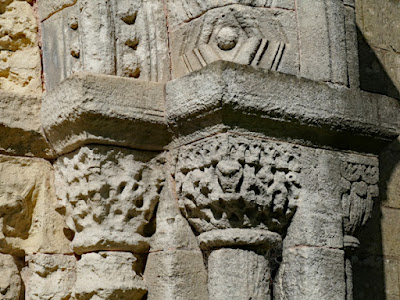Very shortly after arriving at All Saints chapel in the hamlet of Steetley after a 3.5 km walk from Whitwell, where I had seen some very interesting geology and historic architecture – including St. Lawrence’s church - the sun came out and, taking advantage of this to photograph the corbel table, I completely forgot that the chapel is automatically locked at 3:00 pm and I didn't see its interior.
John Charles Cox, in his Notes on the Churches of Derbyshire Vol. 1 (1875) wrote that “the building is quite a gem of early architectural art, indeed it is one of the most complete and beautiful specimens of Norman work on a small scale that can be met with anywhere in this country or in Normandy” and assigned a probable date to the reign of King Stephen (1135-1154).
I just took quick snaps of the individual corbels but, having seen very many C12 churches built in dolomitic limestone from the Permian Cadeby Formation, including corbel tables at St. Lawrence’s church and at St. Peter’s church in Old Edlington, the weathered condition of the individual corbels and the surrounding stonework gave me no reason to think that these were anything but the original stone carvings.
Before Cox’s report, the chapel had been in a dilapidated sate without a roof to the nave for more than 150 years and the major restoration by John Loughborough Pearson (1876-1880) is mentioned by Pevsner and other sources, but the Corpus of Romanesque Sculpture for Britain and Ireland (CRSBI) very surprisingly describes the corbel table as being C19 work.
The Andrews Pages website, which has old photos and illustrations of the chapel, mentions that the Earl of Surrey carefully rebuilt the apse c.1835, but my photos of the corbels shows that they are weathered to a much greater extent than would be expected in stone carvings of this date.
Pevsner and the CRSBI draw attention to the restoration of the south portal and give this a date of 1880 and the lattice work to the gable, the associated beakheads and the 5th order of the round arch to the door surround have sharp profiles.
Although I didn't spent any time closely examining the condition of the stonework of the chapel, detailed photos of the beakheads show that the dolomitic limestone is more weathered than I would probably expect of C19 sculpture, based on my experience of building restoration.
The article by M. F. Stanley, Carved in Bright Stone: Sources of Building Stone in Derbyshire, published in Stone Quarrying and Building in England AD 43-1525 (1990), mentions that the original stone used in the chapel is a fine grained creamy dolomite which shows no sign of weathering; however, it describes the Victorian replacement stone as a coarser dolomite that is grey rather than cream and already shows signs of weathering after 108 years.
I took several general record photographs that show that the first three orders of arches are composed of fine grained creamed coloured limestone, which are weathered to the extent that much of the detail is lost. The outer two orders do appear to be grey and coarse grained in comparison, but I would need to examine them closely, before I could comment further.
Although there has undoubtedly been a considerable amount of restoration to the original C12 masonry of the chapel, including much of the ashlar walling, the only element of the church that is not in a Norman style is the Decorated Gothic window to the south elevation of the nave, which has geometric and mouchette tracery that has clearly been restored.
Stanley mentions that Pearson was presumably unable to obtain stone to match the original, with the difference in grain size possibly contributing to the different weathering properties of the C12 and C19 masonry, but as a specialist in stone identification and matching I only saw notable colour variation in the well bedded yellow/red limestone in the lower part of the west wall.












No comments:
Post a Comment